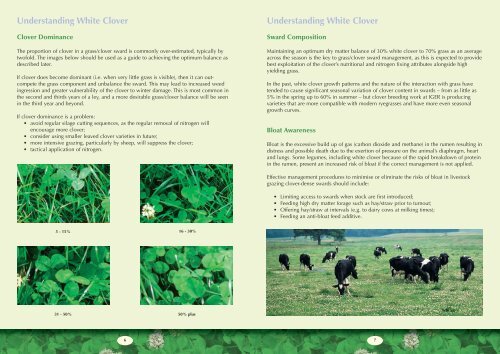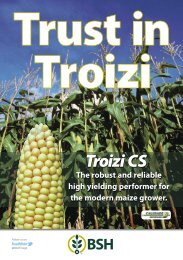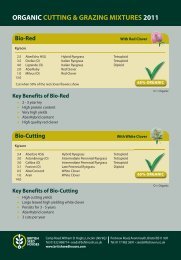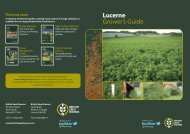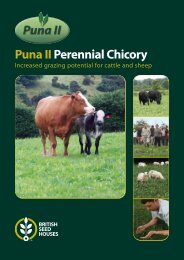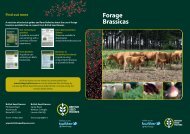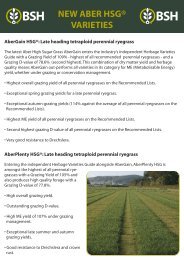Create successful ePaper yourself
Turn your PDF publications into a flip-book with our unique Google optimized e-Paper software.
Understanding <strong>White</strong> <strong>Clover</strong><br />
<strong>Clover</strong> Dominance<br />
The proportion of clover in a grass/clover sward is commonly over-estimated, typically by<br />
twofold. The images below should be used as a guide to achieving the optimum balance as<br />
described later.<br />
If clover does become dominant (i.e. when very little grass is visible), then it can outcompete<br />
the grass component and unbalance the sward. This may lead to increased weed<br />
ingression and greater vulnerability of the clover to winter damage. This is most common in<br />
the second and thirds years of a ley, and a more desirable grass/clover balance will be seen<br />
in the third year and beyond.<br />
If clover dominance is a problem:<br />
• avoid regular silage cutting sequences, as the regular removal of nitrogen will<br />
encourage more clover;<br />
• consider using smaller leaved clover varieties in future;<br />
• more intensive grazing, particularly by sheep, will suppress the clover;<br />
• tactical application of nitrogen.<br />
Understanding <strong>White</strong> <strong>Clover</strong><br />
Sward Composition<br />
Maintaining an optimum dry matter balance of 30% white clover to 70% grass as an average<br />
across the season is the key to grass/clover sward management, as this is expected to provide<br />
best exploitation of the clover’s nutritional and nitrogen fixing attributes alongside high<br />
yielding grass.<br />
In the past, white clover growth patterns and the nature of the interaction with grass have<br />
tended to cause significant seasonal variation of clover content in swards – from as little as<br />
5% in the spring up to 60% in summer – but clover breeding work at IGER is producing<br />
varieties that are more compatible with modern ryegrasses and have more even seasonal<br />
growth curves.<br />
Bloat Awareness<br />
Bloat is the excessive build up of gas (carbon dioxide and methane) in the rumen resulting in<br />
distress and possible death due to the exertion of pressure on the animal’s diaphragm, heart<br />
and lungs. Some legumes, including white clover because of the rapid breakdown of protein<br />
in the rumen, present an increased risk of bloat if the correct management is not applied.<br />
Effective management procedures to minimise or eliminate the risks of bloat in livestock<br />
grazing clover-dense swards should include:<br />
• Limiting access to swards when stock are first introduced;<br />
• Feeding high dry matter forage such as hay/straw prior to turnout;<br />
• Offering hay/straw at intervals (e.g. to dairy cows at milking times);<br />
• Feeding an anti-bloat feed additive.<br />
5 - 15% 16 - 30%<br />
31 - 50% 50% plus<br />
6 7


